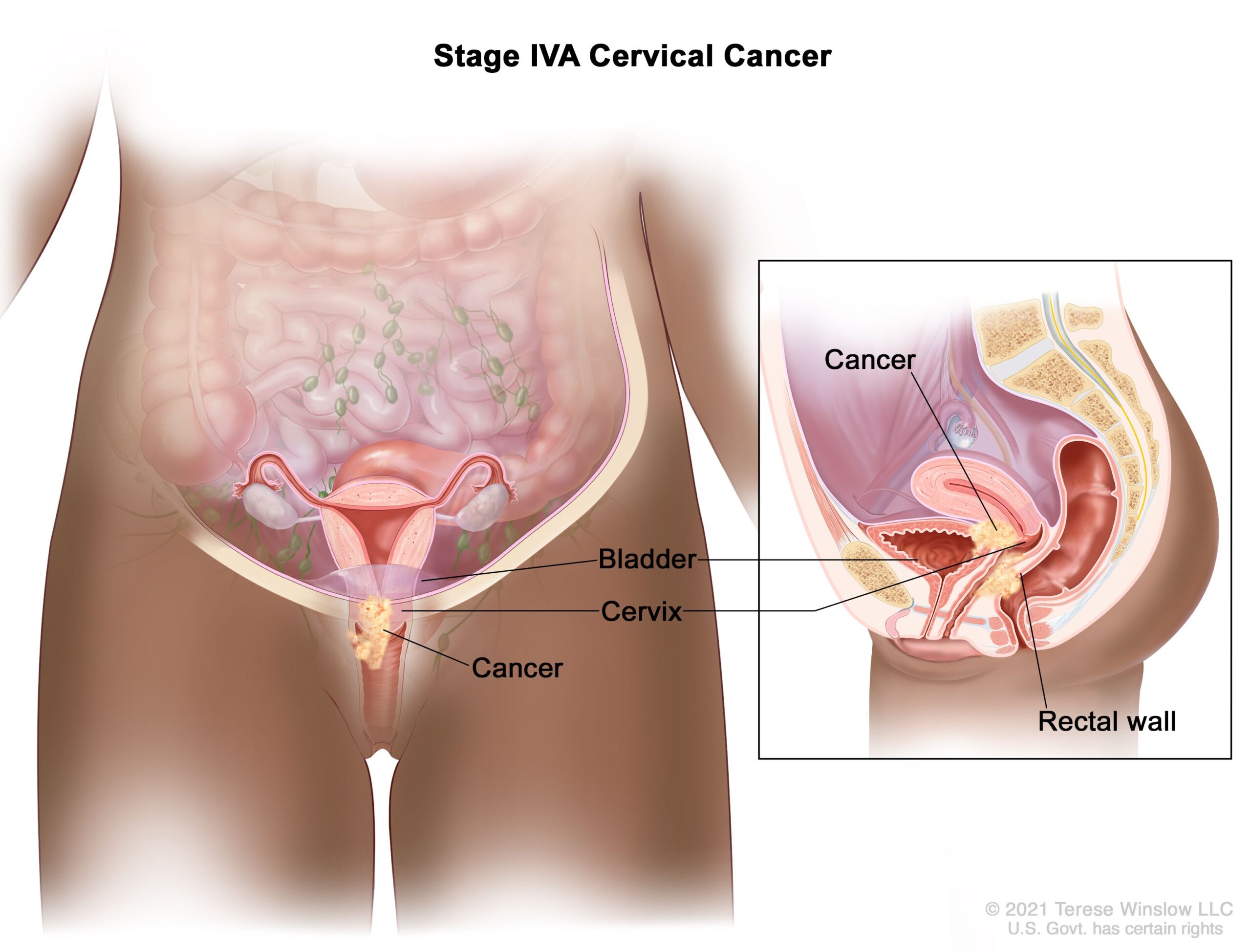
Cervical cancer is a type of cancer that occurs in the cells of the cervix — the lower part of the uterus that connects to the vagina.
SYMPTOMS :
Early-stage cervical cancer generally produces no signs or symptoms.
Signs and symptoms of more-advanced cervical cancer include:
Vaginal bleeding after intercourse, between periods or after menopause
Watery, bloody vaginal discharge that may be heavy and have a foul odor
Pelvic pain or pain during intercourse.
TYPES :
The type of cervical cancer that you have helps determine your prognosis and treatment. The main types of cervical cancer are:
Squamous cell carcinoma.
This type of cervical cancer begins in the thin, flat cells (squamous cells) lining the outer part of the cervix, which projects into the vagina. Most cervical cancers are squamous cell carcinomas.
Adenocarcinoma
This type of cervical cancer begins in the column-shaped glandular cells that line the cervical canal.
CAUSES ;
Cervical cancer begins when healthy cells in the cervix develop changes (mutations) in their DNA.
The mutations tell the cells to grow and multiply out of control, and they don’t die. The accumulating abnormal cells form a mass (tumor). Cancer cells invade nearby tissues and can break off from a tumor to spread (metastasize) elsewhere in the body.
It isn’t clear what causes cervical cancer, but it’s certain that HPV plays a role. HPV is very common, and most people with the virus never develop cancer. This means other factors — such as your environment or your lifestyle choices — also determine whether you’ll develop cervical cancer.
COMPLICATIONS ;.
Many women with cervical cancer will have complications. These can arise as a direct result of the cancer or as a side effect of treatments such as radiotherapy, chemotherapy and surgery.
Complications associated with cervical cancer can range from the relatively minor, such as minor bleeding from the vagina or having to urinate frequently, to life-threatening, such as severe bleeding or kidney failure.
Haani:
STAGING:
If your doctor determines that you have cervical cancer, you’ll have further tests to determine the extent (stage) of your cancer. Your cancer’s stage is a key factor in deciding on your treatment.
Staging exams include:
Imaging tests. Tests such as X-ray, CT, MRI and positron emission tomography (PET) help your doctor determine whether your cancer has spread beyond your cervix.
Visual examination of your bladder and rectum. Your doctor may use special scopes to see inside your bladder and rectum
DIAGNOSIS;
If cervical cancer is suspected, your doctor is likely to start with a thorough examination of your cervix. A special magnifying instrument (colposcope) is used to check for abnormal cells.
During the colposcopic examination, your doctor is likely to take a sample of cervical cells (biopsy) for laboratory testing. To obtain tissue, your doctor may use:
Punch biopsy
, which involves using a sharp tool to pinch off small samples of cervical tissue.
Endocervical curettage
, which uses a small, spoon-shaped instrument (curet) or a thin brush to scrape a tissue sample from the cervix.
DIAGNOSIS;
If cervical cancer is suspected, your doctor is likely to start with a thorough examination of your cervix. A special magnifying instrument (colposcope) is used to check for abnormal cells.
During the colposcopic examination, your doctor is likely to take a sample of cervical cells (biopsy) for laboratory testing. To obtain tissue, your doctor may use:
Punch biopsy
, which involves using a sharp tool to pinch off small samples of cervical tissue.
Endocervical curettage
, which uses a small, spoon-shaped instrument (curet) or a thin brush to scrape a tissue sample from the cervix.
TREATMENT ;
Treatment for cervical cancer depends on several factors, such as the stage of the cancer, other health problems you may have and your preferences. Surgery, radiation, chemotherapy or a combination of the three may be used.
Surgery
Early-stage cervical cancer is typically treated with surgery. Which operation is best for you will depend on the size of your cancer, its stage and whether you would like to consider becoming pregnant in the future.
Radiation
Radiation therapy uses high-powered energy beams, such as X-rays or protons, to kill cancer cells.
Chemotherapy :
Chemotherapy is a drug treatment that uses chemicals to kill cancer cells. It can be given through a vein or taken in pill form. Sometimes both methods are used.
For locally advanced cervical cancer, low doses of chemotherapy are often combined with radiation therapy, since chemotherapy may enhance the effects of the radiation. Higher doses of chemotherapy might be recommended to help control symptoms of very advanced cancer.
Targeted therapy :
Targeted drug treatments focus on specific weaknesses present within cancer cells. By blocking these weaknesses, targeted drug treatments can cause cancer cells to die. Targeted drug therapy is usually combined with chemotherapy. It might be an option for advanced cervical cancer
Immunotherapy;
Immunotherapy is a drug treatment that helps your immune system to fight cancer. Your body’s disease-fighting immune system might not attack cancer because the cancer cells produce proteins that make them undetectable by the immune system cells. Immunotherapy works by interfering with that process. For cervical cancer, immunotherapy might be considered when the cancer is advanced and other treatments aren’t working.
Homoeopathic medicine:
following medicines which are helpful for the treatment of cervical cancer symptoms: Iodum, Kreosotum, Natrum Carb, Carbo Animalis, Thuja, Calcaria Flour, Hydrocotyle, Sabina, Calcaria Carb, Kali Iodide, Sulphuric Acid, Conium, Hydrastis, Sanguinaria, Phosphorous, Lachesis and many other remedies.
Sign up with your name and email to get updates fresh updates.